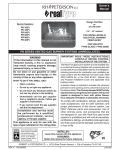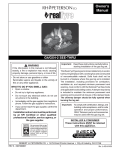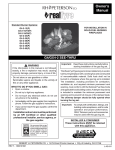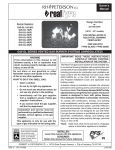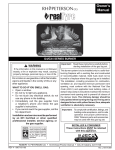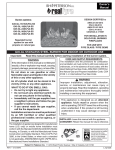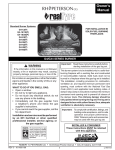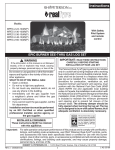Download Real Fyre G45-GL-18 Owner`s manual
Transcript
Robert H. Peterson Co. RHP Owner’s Manual ® GLOWING EMBER GLASS BURNER DESIGN CERTIFIED to Z21.84b-2004 G45 - GL - 18 G45 - GL - 24 G45 - GL - 30 TRIPLE-T BURNER FOR USE WITH GLASS Important: WARNING If the information in this manual is not followed exactly, a fire or explosion may result, causing property damage, personal injury, or loss of life. Do not store or use gasoline or other flammable vapors and liquids in the vicinity of this or any other appliance. WHAT TO DO IF YOU SMELL GAS: • Open a window. • Do not try to light any appliance. • Do not touch any electrical switch; do not use any phone in your building. • Immediately call your gas supplier from a neighbor’s phone. Follow the gas supplier’s instructions. • If you cannot reach your gas supplier, call the fire department. - Installation and service must be performed by a qualified installer, service agency, or the gas supplier. Read these instructions carefully before starting installation of your glass burner. Your Peterson Real-Fyre® glass burner is to be installed only in a solid-fuel burning fireplace with a working flue constructed of noncombustible material. Solid-fuels shall not be burned in a fireplace where this glass burner is installed. The installation, including provisions for combustion, ventilation air and required minimum permanent vent opening, must conform with the National Fuel Gas Code ( ANSI Z223.1/NFPA 54) and applicable local building codes. A damper stop clamp is included to maintain the minimum permanent vent opening and to prevent full closure of the damper blade. The chimney damper MUST be fully opened when operating this burner. Your glass burner is designed to burn with yellow flames; thus adequate ventilation is absolutely necessary. Important: To comply with certification, listings, and building codes, and for safe operation and proper performance, ONLY Peterson parts and accessories MUST be used with this glass burner. INSTALLER & CONSUMER These instructions MUST be retained with this appliance. ROBERT H. PETERSON CO. • 14724 East Proctor Avenue • City of Industry, CA 91746 REV 2- 0701190836 1 No. L-A2-23206 TABLE OF CONTENTS PARTS LIST IMPORTANT INFORMATION FIREPLACE REQUIREMENTS PRE-INSTALLATION REQUIREMENTS PRE-INSTALLATION AND FIREPLACE PREPARATION SAFETY INSTALLATION INSTALLATION (Continued) GLASS PLACEMENT BURNER PREPARATION OPERATING INSTRUCTIONS IMPORTANT OPERATING INFORMATION LIGHTING INSTRUCTIONS CLEANING AND MAINTENANCE MAINTENANCE CLEANING SERVICE FLAME DESCRIPTION OPTIONAL CONTROLS FOR YOUR REAL-FYRE® BURNER SYSTEM OPTIONAL PETERSON VALVES & SAFETY PILOT KITS TROUBLESHOOTING YOUR GLASS BURNER TROUBLESHOOTING YOUR GLASS BURNER (Continued) WARRANTY 3 4 4 4 5 7 8 9 9 10 10 10 11 11 11 11 11 12 13 14 15 16 Available Glass Colors: Tools Recommended The following tools and supplies may be needed to assemble, install, and test your Real-Fyre® glass set: 1. Adjustable open-ended wrench 8" - 10" BL = Black CL = Clear Z = Bronze S = Sapphire E = Emerald 2. Pipe wrench 8" - 10" 3. Pliers FOR YOUR SAFETY 4. Teflon tape or pipe compound resistant to propane gas Note: Use Teflon tape or pipe compound resistant to all gasses on all male pipe threads. Never use pipe compound or brass flare fittings. 5. Small Phillips-head screwdriver & flat head screwdriver 6. Leak detector or soapy water solution & brush to test for gas leaks. 7. Work gloves Other tools used for plumbing or gas appliance installation may be necessary. REV 2- 0701190836 2 Do not store or use gasoline or other flammable vapors and liquids in the vicinity of this or any other appliance. WARNING Improper installation, adjustment, alteration, service, or maintenance can cause injur y or proper ty damage. Refer to this manual. For assistance or additional information, consult a qualified installer, service agency, or the gas supplier. No. L-A2-23206 PARTS LIST Before installation, check that your gas burner system is complete. See the PARTS LIST below. If any parts are missing or damaged, contact your Real-Fyre® dealer. Do not attempt to install or operate the burner if any part appears missing or damaged. Be sure you know the model and size of your set when ordering options or replacement parts and accessories. All drawings & photos in this manual are not to scale. 1 5 2 4 Connector kit 4A 3 4B 6 Item No. Description Qty. 1. Burner pan with Triple-T burner system 1 2. Fuel injector/air mixer 1 3. Damper clamp with bolt 1 4. Connector kit (with elbows) 1 5. Separation grating 1 6. Bag of sand (natural) or Lava-Fyre granules (propane) 1 4C Note: Glass sold separately. Quantity will vary, depending on selection of glass for decorative use. Important: To comply with certification, listing, building code acceptances, and for safe operation and proper performance of this burner system, use ONLY Peterson Real-Fyre® parts and accessories. Use of other controls, parts, and accessories which are not designed for use with Real-Fyre® burner systems is prohibited and will void all warranties, certifications, listings, and building code approvals, and may cause property damage, personal injury, or loss of life. ROBERT H. PETERSON CO. • 14724 East Proctor Avenue • City of Industry, CA 91746 REV 2- 0701190836 3 No. L-A2-23206 IMPORTANT INFORMATION Important: Read this manual carefully before starting installation of the glass burner. Your fireplace must meet venting and construction requirements for the installation of this Real-Fyre® glass burner (see FIREPLACE REQUIREMENTS section below). The burner system must be properly sized for your fireplace. Improper sizing may negatively impact the proper drafting of the fireplace. Additionally, too much glass will adversely affect the burn and hamper the proper operation of the control system. Too little glass will diminish the beauty of the hearth setting. Fig. 4-1 below shows the critical dimensions of your firebox. The table below shows glass set dimensions. FIREPLACE REQUIREMENTS This Real-Fyre® glass burner is to be installed only in a fully vented, noncombustible fireplace with an open damper. The chimney must be free of any obstructions. The fireplace must be designed and approved to burn wood. The Real-Fyre® glass set is designed to burn with yellow, smoky flames. For this reason, it must be adequately vented. The fireplace flue must be at least 8" at its smallest dimension. If it is smaller, do not use this Real-Fyre® glass set. Fig. 4-1 Fireplace Dimensions Rear width The fireplace must have a gas supply line that has been installed by a qualified technician in accordance with all local codes. The gas supply line must be ½" minimum interior diameter. If the gas line to the fireplace is longer than 20', a larger diameter line may be necessary. Height Depth Front width opening Required gas pressure: The minimum inlet gas supply pressure for the purpose of input adjustment is 7" of water column (w.c.) for natural gas and 11" w.c. for propane gas. Note: It is recommended that complete firebox dimensions (front width, back wall, and height) be obtained to ensure proper sizing. The maximum inlet gas supply pressure is 10.5" w.c. for natural gas and 13" w.c. for propane gas. Min. Fireplace Dimensions Model no. Width * BTU Depth Height Front* Rear† Natural Propane G45-GL-18 23" 12" 17" 20" 75M 50M G45-GL-24 27" 12" 17" 20" 90M 65M G45-GL-30 33" 12" 17" 20" 90M 65M Valve Add to width† Manual 4" Series 01 4" † To center burner pan in Series 11 4" fireplace, double Series 15 4" this dimension. Series 16 4" Series 20/21 4" Series 26 4" † Rear width is at corresponding depth. Minimum Free Opening Area of Chimney Damper for Venting (sq. in.) For Factory Built Fireplaces Burner Sizes For Masonry Built Fireplaces Burner Sizes Chimney Height Natural Propane Natural Propane Natural Propane Natural Propane 15' (min.) 20' 30' 47 42 38 31 28 25 56 50 55 40 37 33 51 46 42 35 32 29 60 54 59 44 41 37 18" 24"/30" 18" 24"/30" PRE-INSTALLATION REQUIREMENTS A. Ensure the gas supply to the fireplace is turned off. PRIOR TO INSTALLING THE SET, the gas supply line must be tested. Follow the guide lines set by NFPA 54 or local code requirements. B. Clean the floor of the fireplace of any dirt or ashes. C. Chimney must be cleaned and inspected. Never use propane gas in a set manufactured for natural gas. REV 2- 0701190836 4 No. L-A2-23206 PRE-INSTALLATION AND FIREPLACE PREPARATION SAFETY CAUTION: Installation and repair must be done by an NFI Certified or other qualified professional installer. Installer: Carefully read these instructions before installing this gas burner system. Be sure you understand all safety precautions and warnings contained in this manual. A. This appliance is designed as an attended appliance. Adults must be present when this gas appliance is operating. Do not leave this unit burning when unattended or while anyone is sleeping. B. This appliance is only for use with the type of gas indicated on the rating plate. This appliance is NOT CONVERTIBLE for use with other gases. C. BE CAREFUL: If not installed, serviced, and used correctly, per these instructions, this product can cause serious personal injury, property damage, or loss of life. PRE-INSTALLATION AND FIREPLACE PREPARATION SAFETY GUIDELINES D. WARNING: Before installing in a solid- fuel burning fireplace, the chimney flue, damper, and firebox must be thoroughly CLEANED of soot, creosote, ashes, and loose paint, and must be inspected by a qualified chimney cleaner. Some older fireplaces may need repair prior to installing this appliance. E. CHECK GAS TYPE (natural or propane): The gas supply must be the same as stated on your burner system rating plate. If gas supply is different, DO NOT INSTALL. Contact your dealer for immediate assistance. F. Any outside air ducts and/or ash dumps located on the floor or walls of the fireplace must be permanently sealed shut before the installation. Use a heat-resistant sealant. Do not seal the chimney flue damper. G. INSUFFICIENT GAS PRESSURE WILL KEEP THE PILOT FROM OPERATING PROPERLY. DO NOT USE IF GAS PRESSURE IS LOWER THAN THE MINIMUM REQUIREMENT. 7" water column (w.c.) on natural gas H. The minimum inlet gas supply pressure for purposes of input adjustment is 5" and 11" w.c. on propane gas. Insufficient gas pressure will affect proper operation of the pilot. Do not install this gas appliance if minimum pressure is not available. The maximum inlet gas supply pressure is 10.5" w.c. on natural gas and 13" w.c. on propane gas. The propane source must be regulated. (Do not connect this appliance directly to an unregulated propane gas tank - this can cause an explosion.) I. The gas piping system must be sized to provide minimum inlet pressure at the maximum flow rate (BTU/hr). Undue pressure loss will occur if the pipe is too small, or the run is too long. J. The minimum clearance from the fireplace opening to combustible materials on side walls and ceiling must be maintained as outlined in MINIMUM CLEARANCE TO COMBUSTIBLES - WALLS AND CEILING. K. At least 10"-12" of noncombustible or heat resistant material is required above the fireplace. A fireplace hood will be required to act as a heat deflector in protecting combustible fireplace surrounds (facing and/or mantel) if certain minimum clearances cannot be met. L. Be certain that combustible flooring material (i.e.: carpet, tile, etc.) is not too close to this gas appliance. If this appliance is at floor level or less than 6" above the floor, there must be at least 12" of noncombustible material between the base of the fireplace and any combustible flooring. M. Input ratings shown in BTU per hour are for elevations up to 2,000 ft. For elevations above 2,000 ft., refer to the National Fuel Gas Code or contact the Robert H. Peterson Company before installing this product. N. This gas appliance and its main gas valve must be disconnected from the gas supply piping system during any pressure testing of that system at test pressures in excess of 1/2 psig. O. This gas appliance must be isolated from the gas supply piping system by closing the equipment shut-off valve connected to the gas supply line during any pressure testing of the gas supply piping system at test pressures equal to or less than 1/2 psig. P. Do not use this appliance if any part has been underwater. Immediately call a qualified service technician to inspect the appliance and to replace any part of the control system and any gas control that has been underwater. 5 This page intentionally left blank. 6 INSTALLATION This glass burner must be installed by an NFI Certified or other qualified installer. The installation, including provisions for combustion and ventilation air, must conform with local codes, or in the absence of local codes, with the latest edition of the National Fuel Gas Code (ANSI Z223.1/NFPA 54). TO INSTALL YOUR GLASS BURNER, THE FOLLOWING STEPS MUST BE FOLLOWED. 1. Locate the gas supply line valve The gas supply valve must be OFF before OFF beginning the installation. 2. A damper clamp (see PARTS LIST) is supplied and must be installed on the damper assembly as shown in Fig. 7-1. a. Open your fireplace damper. b. Attach the damper clamp on the damper blade and secure with the bolt. Note: The damper clamp must be permanently installed. Should the clamp not fit, install a permanent damper stop or other means of preventing full or accidental closure. (Such as a screw, bolt, or drilled holes in the damper.) Open Closed Fig. 7-1 Damper clamp in place Use second wrench to stop pipe from turning Important: When the burner is operating, the damper must be fully open. WARNING Failure to position the parts in accordance with these instructions and diagrams, or failure to use only parts specifically approved with this appliance can result in property damage or personal injury. Use wrench to remove stub cap Fig. 7-2 Removing the stub cap 3. Clean fireplace floor of any ashes. 4. Locate the gas supply stub inside the fireplace and remove cap if attached (see Fig. 7-2). CAUTION: When removing the cap make sure the stub does not turn. It will loosen the connection inside the wall. Note: Gas supply pipe must be ½" minimum inside diameter (I.D.) or larger (¾" if gas line is longer than 20'). 5. Attach the large elbow to fireplace gas stub (see Fig. 7-3), using Teflon tape or pipe compound resistant to propane gasses on the stub. Tighten securely. 6. Attach small elbow to the fuel injector or air mixer on burner pan (see Fig. 7-4), using Teflon tape or pipe compound resistant to propane gasses. Tighten securely. DO NOT REMOVE THE FUEL INJECTOR/AIR MIXER 7 Attach large elbow to stub Fig. 7-3 Attaching the elbow Fuel injector or air mixer Attach small adapter to fuel injector on burner pan Fig. 7-4 Adapter on pan INSTALLATION (Continued) 7. Connect the elbows with the tubing supplied (Fig. 8-1). DO NOT kink tubing. Tighten both ends securely. On gas supply stub Connect both elbows with tubing On burner pan Fig. 8-1 Connector installed Position the burner pan in the center of the fireplace. Do not push up against the rear fireplace wall. 8. Leak testing Carefully turn on the gas supply, ignite the burner pan, and leak test at all connections with a soapy water solution (equal parts liquid detergent and water) at all connections. If bubbles appear, a leak is present. Turn off gas and tighten connection, turn on gas and repeat leak test. Repeat until no leaks are detected. Never use a flame to test for leaks. When satisfied there are no leaks, turn off the gas supply and proceed. 8 GLASS PLACEMENT BURNER PREPARATION Burner pan After hooking up the burner to the fireplace gas supply and placing the heat shield on the valve assembly (if purchased), the media (sand, vermiculite, and glass) must be added for the burner to function as designed. Note: These instructions show sand being used as a base for the glass, but only natural gas burners use sand. For propane burners, follow these instructions using Lava-Fyre granules in place of sand. Fig. 9-1 WARNING The burner and pilot (if equipped) must be OFF (fully extinguished) and all valve covers must be in place before pouring media onto the burner. It may also be necessary to temporarily cover the pilot assembly (if equipped) to keep glass and sand out of it during this procedure. Fig. 9-2 SAND/GRANULE PLACEMENT 1. Pour the entire bag of sand (natural) or granules (propane) directly onto the burner pan (Fig. 9-2). Separation grating Note: Keep the media in the pan as much as possible (it is natural for a little bit to spill out the front of the pan onto the fireplace floor). 2. Smooth out the media so that it conforms roughly to the wedge shape of the pan (Fig. 9-2). 3. Place the perforated metal support grid over the sand or granules so that the angled part hooks over the top and back of the burner pan, as shown in Fig. 9-3. Fig. 9-3 GLASS PLACEMENT CAUTION: Glass pieces may be sharp. Be careful handling the glass. Use hand protection, such as gloves, if necessary. 1. Pour the glass directly on top of the support grid so that the burner pan is covered completely and evenly (Figs. 9-3, 9-4). Fig. 9-4 Note: At this stage the burner will function as designed, however, more glass may be added around the burner for decorative purposes. If glass is desired behind the burner pan it may be left at a lower level than the back of the pan, as shown in Fig. 9-5, or raised up to or above the level in the back of the pan. 2. Add additional decorative glass around the burner pan as desired (Fig. 9-5). Fig. 9-5 9 OPERATING INSTRUCTIONS IMPORTANT OPERATING INFORMATION WHEN THE BURNER IS BURNING, YOUR FIREPLACE DAMPER MUST BE FULLY OPEN. A fireplace screen must be in place when the glass is burning. Unless other provisions for combustion air are provided, the screen shall have an opening(s) for introduction of combustion air. WHEN A GLASS FIREPLACE ENCLOSURE (DOOR) IS USED, OPERATE THE GLASS BURNER WITH THE GLASS DOORS OPEN. Before operating your glass set: 1. Be sure your fireplace is free from flammable liquids or combustible materials. 2. Be sure your damper is open. 3. Smell all around the glass burner for the odor of escaping gas. IF YOU SMELL GAS, FOLLOW THE INSTRUCTIONS ON PAGE 1. LIGHTING INSTRUCTIONS If your glass burner is operated by the fireplace valve: 1. Lay a lighted long-stem match on the surface of the glass near the gas inlet (do not hold the match in your hand) or use a lighted long-necked butane lighter (Fig. 10-1). 2. Slowly turn the fireplace to the ON position. Your glass set should light. 3. If the glass does not light before the match goes out, immediately turn off the gas to the unit. 4. Wait approximately five (5) minutes to clear out any gas, and repeat steps 1-3 (above). 5. If your glass fails to light again, turn off the gas to the unit and contact your dealer or gas supplier. Fig. 10-1 Apply match-then turn on gas 6. To extinguish your glass burner, make sure the valve is turned fully OFF to avoid any gas leakage. If your glass burner is operated by a Peterson manual safety pilot system (SPK Series) or a Peterson remote safety pilot system (APK Series): 1. Carefully follow the LIGHTING INSTRUCTIONS supplied with your Peterson pilot system for the steps to ignite the burner. 10 CLEANING AND MAINTENANCE MAINTENANCE SERVICE Once installed and operating properly, your RealFyre® glass burner will require regular maintenance. You should inspect your glass burner and controls (where installed) for the following: While some minor service conditions should be handled by the owner of the glass burner, a qualified, professional service technician should be called to maintain and service your glass burner and any installed control systems. In addition, a periodic examination and cleaning of the solid-fuel burning fireplace venting system should be conducted by a qualified, professional service technician. The TROUBLESHOOTING section of these instructions serves as a guide for ensuring optimum performance of your glass burner. 1. Moisture may cause the glass in your burner pan to settle. To improve the burn, follow these tips: a. Settling of glass - Using a screwdriver or flat blade knife, carefully stir the glass, loosening the material. Clear up any spills. 2. Debris around the control (where used) Inspect control and pilot to be sure they are free of dirt or debris. To protect your investment in your Real-Fyre® gas fireplace burner system and keep it operating safely for years to come, maintain, clean, and inspect it regularly. We recommend following these instructions at the beginning of each fireplace season and as needed throughout the year, depending on your usage pattern and the environmental conditions in your home. More frequent cleaning and maintenance may be necessary when burning propane gas than with natural gas. 3. Insects and burner blockage - Check the burner ports and air shutter, if present, to make sure they are free from debris. Blocked burner ports and orifices may result in a fire at the air shutter. CLEANING The pilot assembly must be kept clean and clear of debris at all times for the fireplace burner system to be safely and effectively operated. Dust, carpet fibers, paper, spider webs, pet hair, etc. in fireplace or on the burner assembly can affect operation of burner and pilot assembly. Vacuum or use compressed air from a can or compressor to clean out pilot assembly area, air shutter holes, burner orifices, and pilot air intake openings. Blockage in this area will affect the operation of pilot assembly. • Replace all batteries for remote transmitters and receivers if installed. • Check and re-adjust the burner air shutter. • Clean and test the ignitor and pilot. • Remove and clean artificial logs and/or glass. FLAME DESCRIPTION Observe the flames. The flames should be blue at the base and a combination of blue/yellow at the body and tips. The flames should be 16" to 18" tall. (See Figure 11-1). Figure 11-1 11 OPTIONAL CONTROLS FOR YOUR REAL-FYRE® BURNER SYSTEM This unit may come without a valve installed. It may be connected directly to and operated by your fireplace valve. Alternatively, your Real-Fyre® glass burner may be operated using a number of optional Peterson control systems (listed below). Peterson control systems are engineered to provide convenient, safe, and reliable operation of your gas burner system. For safe operation, proper performance, and to comply with safety standards and certifications, use only Robert H. Peterson Company control systems, parts, and accessories with your Real-Fyre® burner system. If you have purchased a valve separately, follow the installation instructions that come with your control system. Peterson Control System and Combinations Primary Control Method Manual On/Off Systems Manual on/off knob (match lit, no pilot) Manual on/off rod handle (match lit, no pilot) Manual Safety Pilot Systems* Safety pilot w/ knob Safety pilot w/ rod handle Low profile valve Piezo spark pilot ignition Piezo intermittent ignition pilot Remote Safety Pilot Systems* Toggle switch Wall switch Wall timer Wood chip switch RUS remote Remote Deluxe remote Pine cone remote receiver Variable flame height remote RVF remote Wall switch (variable w/switch) Variable flame height remote Deluxe variable flame height remote Pine cone remote receiver Wall switch Order # AV-17 AV-18 SPK-20 SPK-21 SPK-26 SPK-32 SPK-33 N/A WS-1 WS-2 WCS-1 RUS-1 RR-1 RR-2 PC-105 N/A RVF-1 WS-3 VR-1A VR-2A PC-106 WS-4 And also requires one of: APK-11(M)(P) or APK-10(M)(P) or EPK-01 APK-15 (only) APK-15(P) APK-16 *When systems are to be used with propane gas, add a "P" to the control model no. (e.g., APK11MP). Propane glass sets require a safety pilot system. Not all safety pilot systems are available for all glass set sizes. **"M" stands for remote capable systems for installations that already have a suitable remote. 12 OPTIONAL PETERSON VALVES & SAFETY PILOT KITS Note: For all valves and safety pilot kits shown on this page, carefully follow the instructions supplied with your safety pilot kit for steps to assemble and install it on the burner pan and test for leaks. SPK-20 *Available from your local Real-Fyre® dealer APK-11 Fuel injector Main burner pipe Aluminum tubing Burner pan Fuel injector Main burner pipe Burner pan Hearth elbow Gas supply line APK-11 remote ready Adapter valve Front burner Fireplace floor Fireplace floor Aluminum tubing Fig. 13-4 SPK-26 APK-15 Fuel injector Aluminum tubing SPK-26 Valve APK-15 Valve APK-15 remote safety valve Fig. ON 0FF Fireplace floor Gas supply line PILOT L Adapter Front burner SPK-26 Hearth safety elbow valve Fireplace floor Burner pan Main burner pipe Aluminum tubing Adapter Front burner Fuel injector Hearth elbow Burner pan Main burner pipe Fig. 13-1 Gas supply line Note: Heat shield is not shown, but must be in place when operating your glass burner. SPK-20 Note: Heat shield is not shown, but must be in place when operating your glass burner. APK-11 Valve SPK valve Front burner Fig. 13-5 APK-10 Hearth elbow Aluminum tubing Fuel injector Main burner pipe Note: Heat shield is not shown, but must be in place when operating your glass burner. 13-2 Hearth elbow Gas supply line Burner pan Adapter APK-10 remote safety valve Front burner Fireplace floor APK-16 Main burner pipe Burner pan Front burner Fireplace floor APK-16 APK-10 Valve Fuel injector Aluminum tubing Adapter APK-16 remote safety valve Fig. 13-3 Gas supply line Fig. 13-6 AV-17 AV-18 Note: Heat shield is not shown, but must be in place when operating your glass burner. Fuel injector Main burner pipe Burner pan Flared adapter Aluminum tubing Hearth elbow Note: Heat shield is not shown, but must be in place when operating your glass burner. Front burner ON/OFF valve Fireplace floor Fig. 13-7 13 Gas supply line Hearth elbow TROUBLESHOOTING YOUR GLASS BURNER SYMPTOM 1. Smoking and/or sooting CAUSE A. Poor draft or down draft A. Check for chimney blockage. Be sure chimney is at least 3' taller than anything within 10' of it in all directions. If not, consult a chimney sweep. Chimney cap or fan may help. Under severe conditions, you may need to open a window near the fireplace about 1" to 2" when burning the glass. B. Improper burner for gas used B. Use only a natural gas set with natural gas or use only a propane gas set with propane gas. C. Damper closed C. Open damper fully when operating glass burner. D. Burner is positioned too close to the front of the firebox D. Move set so that the back of the grate touches the center of the firebox. E. Improper glass placement or amount E. See PLACEMENT OF GLASS section. F. Flue is less than 8" in diameter F. R e m ove t h e bu r n e r a n d glass. Inadequate fireplace ventilation. G. Air mixer on propane set is closed G. Open air mixer completely. A. Incorrect glass, vermiculite, or sand for type of gas used A. Consult your dealer for proper set. B. Insufficient gas supply B. Other gas appliances may be competing for gas supply. Consult installer or plumber. Orifice size is based upon 7" w.c. pressure for natural gas and 11" w.c. pressure propane gas. Plumbing must supply adequate pressure. C. Blockage or kink in connector kit, plumbing or burner orifice C. Clean out blockage. If connector kit is kinked, replace it. D. Valve not fully open D. Open valve fully. ( I M M E D I AT E LY STOP USING. Call your gas supplier or another qualified professional installer or service agency.) 2. Low flame SOLUTION 14 TROUBLESHOOTING YOUR GLASS BURNER (Continued) SYMPTOM 3. Uneven flame distribution (Lower at one end of the burner) 4. Flame at air mixer (For propane units) CAUSE SOLUTION A. Clogged or blocked port holes A. Burner ports can be cleared of foreign objects by running a wire through them. B. Insufficient gas pressure and/or supply B. Consult installer or plumber (see solution 2B). C. Glass or sand may be packed down too tightly C. Loosen glass around burner pipe by running a kitchen knife along both sides of the pipe. Even out glass in burner pan. D. Auxiliary shut-off valve partially closed D. Open valve fully. Usually, you will find this along the wall 3' from the fireplace. A. Clogged or blocked burner ports A. Burner ports can be cleared of foreign objects by running a wire through them. B. Insufficient gas pressure and/or supply B. Consult installer or plumber (see solution 2b). C. Glass or sand may be packed down too tightly C. Loosen glass around the burner by running a kitchen knife along both sides of the pipe. Be sure glass is used with an air mixer. D. Excessive gas pressure D. Contact your gas supplier. 15 WARRANTY PETERSON VENTED DECORATIVE GAS APPLIANCE LIMITED WARRANTY All Peterson burner assemblies are WARRANTED for TEN (10) YEARS. All Peterson glass is WARRANTED for TEN (10) YEARS. SPK-26 controls are covered by a THREE (3) YEAR “All Parts” Warranty. All other Peterson valves, pilots, and controls are covered by a ONE (1) YEAR Limited Warranty (excluding batteries). This warranty applies only to the original purchaser, from the date of purchase, and to Peterson products purchased for residential purposes. This warranty does not cover parts becoming defective by misuse, accidental damage, electrical damage, improper handling, and/or installation or service (burners must be installed as outlined in the enclosed instructions by a qualified, professional installer and with only Peterson parts, control valves, remotes, and accessories). It does not cover labor or labor-related charges. It specifically excludes liability for indirect, incidental, or consequential damages. Some states do not allow the exclusion or limitation of incidental or consequential damages, so the above exclusion or limitation may not apply to you. This warranty gives you specified legal rights and you may have other rights which may vary from state to state. For additional information regarding this warranty, or information on how to place a warranty claim, contact your Peterson dealer or the Robert H. Peterson Company. ROBERT H. PETERSON CO. Quality Check Date:___________ Orifice # (Main):__________ Orifice # (Other):__________ Leak Test: ___________ Burn Test: ___________ Gas Type: NAT. / PROPANE Model #: ___________ Serial #: ___________ Air Shutter: ___________ Inspector: ___________ Robert H. Peterson Co. • 14724 East Proctor Ave. • City of Industry, CA 91746 16
















